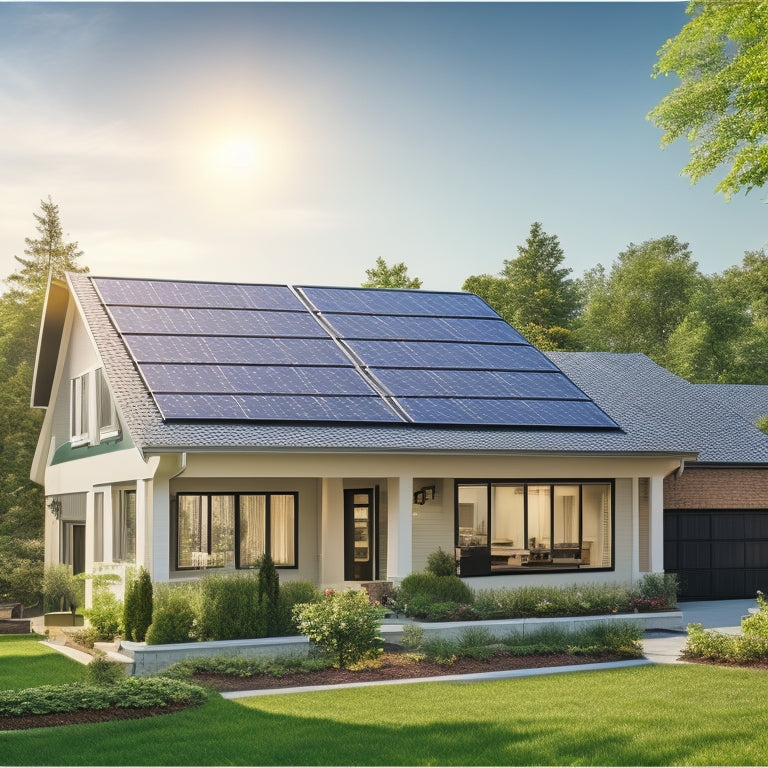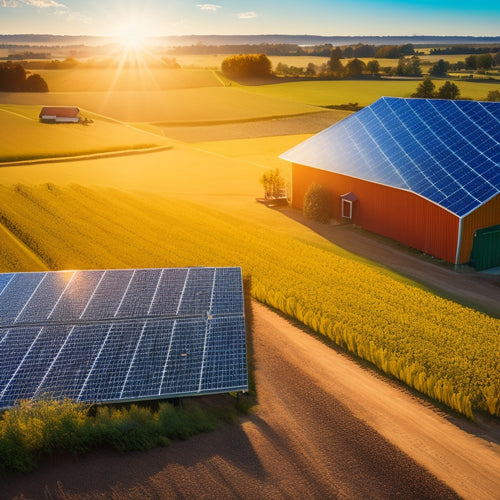
What's the True Cost of Solar Panel House Installation
Share
You're likely to invest around $15,000 to $30,000 in a solar panel house installation, but the true cost goes beyond the initial sticker price, depending on various factors such as equipment quality, labor costs, roof complexity, and local incentives. The type of solar panel, inverter, and mounting hardware you choose greatly affects overall cost, while labor costs and installation fees are influenced by the complexity of installation and system size. Permitting and inspection fees, battery backup and storage costs, maintenance and repair expenses, and available incentives and tax credits also play a role. You'll want to contemplate these factors carefully to get a clear illustration of the total cost of going solar.
Key Takeaways
- The true cost of solar panel house installation includes equipment and material expenses, labor costs, permit and inspection fees, and other factors.
- The type of solar panel, inverter, and mounting hardware significantly impact overall costs, with high-quality equipment often costing more.
- Labor costs vary depending on the complexity of installation, system size, and local service rates, with skilled professionals required for a successful installation.
- Additional costs include permit and inspection fees, which can range from $500 to $2,000, as well as potential costs for battery backup and storage.
- Homeowners can benefit from incentives and tax credit savings, such as the federal tax credit, state rebates, and performance incentives, to reduce the overall cost of installation.
Understanding Solar Panel Costs
Most homeowners pondering solar panel installation are keenly interested in understanding the costs involved. You're likely wondering what you'll need to budget for and what returns you can expect.
Solar financing options are available to help make the shift more affordable. An energy savings analysis will help you understand how much you'll save on your utility bills. You'll also want to reflect on the environmental impact of switching to clean energy.
Additionally, you'll need to factor in grid connection fees, which vary depending on your location. However, the long-term benefits of solar energy far outweigh the initial costs.
With rapid technology advancements, the efficiency of solar panels is increasing, making them a more viable option. Your homeowner preferences, such as the size of your system and the type of equipment, will also influence the overall cost.
Be sure to research system warranties and local regulations, which can impact your installation timelines. By understanding these factors, you'll be better equipped to make an informed decision about investing in solar energy.
Equipment and Material Expenses
You've likely factored in the overall cost of solar panel installation, but now it's time to break down the expenses involved in equipment and materials. These costs can vary depending on the type and quality of the equipment you choose.
-
The type of solar panel you select will greatly impact your overall cost. For example, monocrystalline panels are more expensive than polycrystalline panels, but they're also more efficient.
-
Installation warranties are essential, and you should expect to pay more for a longer warranty period. A 25-year warranty is standard, but some companies offer 30-year warranties for an added cost.
-
Mounting hardware, such as racking and tracking systems, will also add to your expenses. These systems can increase the efficiency of your panels, but they come at a higher cost.
- Inverters, which convert DC power to AC power, are another significant expense. You'll need to decide between a string inverter, microinverter, or power optimizer, each with its own price point and benefits.
Labor Costs and Installation Fees
You'll need to factor in labor costs and installation fees, which include permit and inspection fees, installation team wages, and equipment and materials necessary for the job.
These expenses can vary depending on the complexity of your installation and the size of your solar panel system.
To get an accurate estimate, you'll want to research the going rates for these services in your area.
Permit and Inspection Fees
Your solar panel installation project involves more than just purchasing the panels themselves.
You'll need to evaluate the permitting process, which can add significant costs to your overall project. These fees cover the cost of obtaining necessary permits and undergoing inspections to guarantee your system meets local building codes and safety standards.
Permit and inspection fees vary by location, but here are some typical costs you can expect:
- Building permits: $500-$2,000
- Electrical permits: $100-$500
- Inspection fees: $100-$500
- Utility company connection fees: $100-$500
These fees may seem like a drop in the bucket compared to the overall cost of your solar panel system, but they can add up quickly.
Be certain to factor them into your budget to avoid surprise costs down the line. Additionally, be prepared to provide documentation and access to your property for inspectors to verify that your system meets local regulations.
Installation Team Wages
The largest single component of the overall cost of solar panel installation is typically the labor cost, which can account for nearly half of the total expense. This is because the installation process requires a team of skilled professionals, including electricians, roofers, and engineers, who work together to guarantee a safe and efficient installation.
You'll find that the wages of the installation team can vary markedly depending on factors such as location, experience, and company size. A wage comparison between different installation companies can reveal major discrepancies, with some companies paying their teams considerably more than others. This is often reflected in the final cost of the installation.
The installation team interactions also play an important role in determining the labor cost. A well-coordinated team with a clear division of labor can complete the installation more quickly and efficiently, reducing the overall labor cost.
On the other hand, a team with poor communication and coordination can lead to delays and increased costs. As you consider the cost of solar panel installation, it's vital to factor in the labor cost and make sure that you're working with a reputable and efficient installation team.
Equipment and Materials
While labor costs dominate the overall expense of solar panel installation, equipment and materials also play a significant role, accounting for a substantial portion of the total cost.
You'll need to evaluate the type and quality of solar panels, inverters, mounting hardware, and other components that make up your system.
Here's a breakdown of the key equipment and materials you'll need to factor into your budget:
- Solar panel types: Monocrystalline, polycrystalline, or thin-film panels, each with varying efficiencies and price points
- Inverters: String inverters, microinverters, or power optimizers, which convert DC power to AC for your home
- Mounting hardware: Racking and tracking systems that secure your panels to your roof or ground
- Installation warranties: Look for warranties that cover equipment, labor, and performance for 25 years or more
These components, along with installation warranties, will impact the overall cost of your solar panel installation.
Be sure to research and compare prices from different manufacturers and suppliers to get the best value for your money.
Roof Size and Complexity Factors
When you're considering solar panel installation, you'll need to factor in your roof's size and complexity.
A larger roof requires more materials and labor, increasing costs, while a steep roof can pose challenges for installers, adding to the expense.
Additionally, obstacles like skylights, vents, and unusual angles can further complicate the installation process, driving up costs.
Roof Size Matters
Your roof's size and complexity play a significant role in determining the cost of solar panel installation. A larger roof requires more solar panels to generate the same amount of energy, which increases the overall cost. Additionally, a complex roof with multiple angles, skylights, or vents may require specialized installation techniques, adding to the expense.
Some key factors to evaluate when pondering your roof's impact on solar panel installation costs include:
-
Roof orientation: A south-facing roof receives the most sunlight, making it ideal for solar panels. East- or west-facing roofs may require more panels to achieve the same energy output.
-
Shading issues: Trees, chimneys, or other obstructions can cast shadows on your roof, reducing energy production and increasing the number of panels needed.
-
Aesthetic considerations: You may want to choose panel types that blend with your roof's style and color to maintain your home's appearance.
- Future expansion: If you plan to add more solar panels in the future, your roof's size and complexity will impact the installation cost and logistics.
Steep Roof Challenges
Steep roofs can considerably impact the cost and complexity of solar panel installation. You'll face unique challenges when dealing with a roof pitch that's too steep. Installation becomes more complicated, and safety concerns arise. The steeper the roof, the more difficult it's for installers to access, which drives up labor costs and increases the risk of accidents.
Structural integrity is also a concern, as the added weight of solar panels can put additional pressure on your roof. You'll need to verify your roof can handle the extra load, which may require additional reinforcements.
Drainage issues can also arise, as water may collect on the roof, potentially damaging your solar panels. Weather impacts, such as high winds and heavy snowfall, can further complicate installation and affect long-term durability.
Design considerations, like confirming the panels are securely fastened, become critical. Furthermore, the aesthetic impact of solar panels on a steep roof may be more noticeable, which could affect your home's curb appeal.
Obstacles and Angles
Roof size and complexity factors, including obstacles and angles, play a crucial role in determining the true cost of solar panel installation.
You'll want to evaluate these factors carefully, as they can greatly impact the overall cost of your project.
For instance, a larger roof requires more solar panels, which increases the cost. On the other hand, a complex roof with multiple angles, vents, and skylights can make installation more difficult, leading to higher labor costs.
Additionally, solar panel aesthetics can be affected by roof size and complexity, which may impact your home's resale value.
Some key factors to evaluate include:
- Roof size and shape: Larger roofs require more solar panels, increasing the cost.
- Obstacles and angles: Complex roofs with multiple angles, vents, and skylights can increase labor costs.
- Installation timing: Installing solar panels during peak season (summer) may be more expensive than during off-peak seasons.
- Local building codes and regulations: Compliance with local building codes and regulations can add to the overall cost.
Energy Efficiency and Output
One key aspect of solar panel installation is the system's energy efficiency and output, which directly impact the amount of electricity generated and the resulting savings on your utility bills.
Your solar panel system's energy efficiency refers to how well it converts sunlight into electricity. Solar efficiency is typically measured by the percentage of sunlight that's converted into usable electricity. For example, a solar panel with 20% efficiency can convert 20% of the sun's energy into electricity.
The energy output of your solar panel system is critical in determining how much electricity you'll generate and how much you'll save on your utility bills. The output is typically measured in watts (W) and is calculated based on the system's size, solar panel efficiency, and the amount of sunlight your location receives.
A higher energy output means you'll generate more electricity and enjoy greater savings on your utility bills. When selecting a solar panel system, look for high-efficiency panels with a high energy output to maximize your return on investment.
Permitting and Inspection Fees
During the solar panel installation process, you'll need to secure necessary permits and undergo inspections to confirm your system meets local building codes and safety standards. This involves steering through the permitting process, which can be complex and time-consuming. You'll need to research and comply with local regulations, submit applications, and await approval.
Some key factors to take into account:
-
Application timelines: Be prepared for varying application timelines, which can range from a few days to several weeks, depending on the jurisdiction.
-
Fee structures: Permitting and inspection fees vary by location, but expect to pay anywhere from $500 to $2,000 or more, depending on the complexity of your project.
-
Documentation needed: Gather required documents, such as system design plans, electrical diagrams, and manufacturer specifications, to confirm a smooth permitting process.
- Variance applications: Be prepared for potential project delays if you need to file variance applications due to non-compliant system designs or unique installation requirements.
Battery Backup and Storage Costs
After traversing the permitting process, you'll want to contemplate another key aspect of your solar panel installation: battery backup and storage costs. This vital component guarantees energy independence by storing excess energy generated during the day for use during the night or power outages. The cost of battery backup and storage varies depending on installation options, system efficiency, and usage patterns.
| Battery Type | Cost Range |
|---|---|
| Lead-Acid | $200-$500 per kWh |
| Lithium-Ion | $500-$1,000 per kWh |
| Flow Battery | $1,000-$2,000 per kWh |
When selecting a battery, consider factors such as battery lifespan, cost savings, and environmental impact. Technology trends suggest that Lithium-Ion batteries are becoming increasingly popular due to their high efficiency and long lifespan. Financing options and grid integration are also significant considerations when choosing a battery backup and storage system. By understanding these factors, you can make an informed decision that aligns with your energy needs and budget.
Maintenance and Repair Expenses
As you settle into your new solar-powered lifestyle, you'll want to take into account the ongoing maintenance and repair expenses that come with owning a solar panel system.
While solar panels are designed to last for up to 30 years or more, they still require regular maintenance to guarantee peak performance.
Some key factors to keep in mind include:
-
Maintenance frequency: You'll need to clean your solar panels regularly to remove dirt and debris, which can reduce energy output. The recommended cleaning frequency varies depending on your location and climate.
-
Repair costs: While rare, solar panel repairs can be costly. Fortunately, many manufacturers offer warranty coverage for parts and labor for a certain period, usually 10-25 years.
-
Warranty coverage: Understand the terms of your warranty and what's covered in case of repairs or replacements.
- Performance monitoring: Regular monitoring of your system's performance can help identify potential issues before they become major problems. This can be done through online portals or mobile apps.
Incentives and Tax Credit Savings
You've invested in a solar panel system, and now it's time to reap the financial benefits. As a homeowner, you're eligible for various incentives and tax credits that can greatly reduce the overall cost of your solar panel installation.
At the federal level, you can claim a tax credit of up to 26% of the total installation cost. Additionally, many states offer rebates and performance incentives that can further reduce your expenses. Local programs may also provide financing options, such as solar loans, to help you cover the upfront costs.
When filing your taxes, you can claim tax deductions for the interest paid on your solar loan. You may also be eligible for energy credits, which can be sold or traded to reduce your electricity bills. Some states even offer property tax exemptions or reductions for solar-powered homes.
It's essential to research and take advantage of these incentives, as they can greatly impact your return on investment. By combining federal, state, and local incentives, you can maximize your savings and enjoy the long-term benefits of solar power.
Frequently Asked Questions
Can I Install Solar Panels Myself to Save on Labor Costs?
You can attempt a DIY installation to save on labor costs, but be prepared to handle complex electrical work and obtain necessary solar panel permits, which can be time-consuming and may void your warranty.
How Long Does a Typical Solar Panel House Installation Take?
You're likely wondering how long it'll take to get your solar panel house installation up and running. Consider a typical residential project like the Smith's 5-kW system, which required 3-5 days of installation after 2-3 weeks of project preparation, permits, and inspections, totaling a 5-6 week installation timeline.
Do Solar Panels Work Efficiently in Cloudy or Shaded Areas?
You'll find that solar panels don't operate at peak solar efficiency in cloudy or shaded areas, but shading solutions like panel tilting and micro-inverters can help mitigate energy losses, ensuring you still generate power despite less-than-ideal conditions.
Can I Finance My Solar Panel Installation Through a Loan?
You can finance your solar panel installation through various loan options, enjoying financing benefits like low interest rates, flexible repayment terms, and potential tax incentives, making your change to renewable energy more accessible and affordable.
Will Solar Panels Increase My Property Value and Saleability?
You'll enhance your property's market appeal and increase equity by installing solar panels, as they're a desirable feature for eco-conscious buyers, potentially adding thousands to your sale price and making your home more attractive to potential buyers.
Conclusion
As you weigh the benefits of utilizing the sun's power, the true cost of solar panel house installation comes into focus. Like a puzzle, each component - equipment, labor, roof complexity, and more - fits together to form a complete image. With every piece in place, the financial environment shifts, revealing a clearer path to energy independence.
Related Posts
-

Off-Grid Solar Solutions for Sustainable Farming
Off-grid solar solutions can revolutionize your farming operations by providing energy independence and significant c...
-

Integrating Smart Technology for Energy Savings
Integrating smart technology into your home is a transformative factor for energy savings. Smart thermostats give you...
-

How to Reduce Home Energy Bills
To reduce your home energy bills, start by investing in energy-efficient appliances and upgrading your insulation. Lo...


